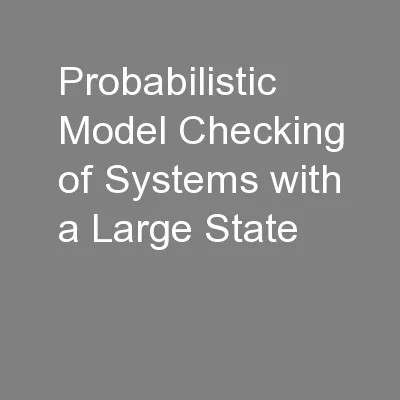

Shoupon Lin Advisor Nicholas F Maxemchuk Department of Electrical Engineering Columbia University New York NY 10027 Problem Markov decision process or Markov chain with exceedingly large state space ID: 431791
Download Presentation The PPT/PDF document "Probabilistic Model Checking of Systems ..." is the property of its rightful owner. Permission is granted to download and print the materials on this web site for personal, non-commercial use only, and to display it on your personal computer provided you do not modify the materials and that you retain all copyright notices contained in the materials. By downloading content from our website, you accept the terms of this agreement.
Slide1
Probabilistic Model Checking of Systems with a Large State Space: A Stratified Approach
Shou-pon
Lin
Advisor: Nicholas F.
Maxemchuk
Department
of
Electrical
Engineering,
Columbia
University,
New
York,
NY
10027
Slide2
Problem: Markov decision process or Markov chain with exceedingly large state spaceCheck if the
Markov decision process or Markov
chain satisfies a given probabilistic safety propertySolution: Not completely traverse all states, but prioritize state traversal on those states that are more likely to be reached during system execution; stop when using up all the memoryCompute probability bound by considering the uncertainty contributed by unexplored states
Model checking probabilistic system
2Slide3
Probabilistic safety propertiesA probabilistic safety property combines a regular safety property and a probability bound between 0 and 1
For all adversary , the probability for to satisfy should be greater than or equal to
3Slide4
Reachability analysisNormally it can be done by taking the product , find the set of acceptance states , and solve a linear program to find
4Slide5
Discretized levels of probabilistic choicesGiven a layering parameter ,
probabilistic choices are categorized into several discretization
levelsIf level-0 (high probability choices)If level-1 low probability choicesIf
level-2
low probability
choices
etc.
5Slide6
Stratified traversalAssign discretized levels to probabilistic transitions
6Slide7
Stratified traversalPrioritize traversal of more probable states
7Slide8
Stratified traversalPrioritize traversal of more probable states
8Slide9
Stratified traversalPrioritize traversal of more probable states
9Slide10
Stratified traversalThe unexplored states are the less likely ones to be reached during system execution
10Slide11
Stratified traversalThe unexplored states are the less likely ones to be reached during system execution
11Slide12
Determine if the property holdsLet
Suppose the procedure stops when finishing layer kIf , holdsIf , is violatedOtherwise, whether holds or not is uncertain12Slide13
Determine if the property holdsLet
Suppose the procedure stops when finishing layer kIf , holdsIf , is violatedOtherwise, whether holds or not is uncertain13Slide14
Preliminary resultsWe applied stratified
verification to
the lock protocol that resolves conflicting reqs in our automobile application.Stratified method is able to compute the upper-bound of error probability while PRISM terminates when running out of memory
14Slide15
Future worksFeasibility of integrating this method into currently available model checkers and state-of-art techniques
15Slide16
Future worksFeasibility of integrating this method into currently available model checkers and state-of-art techniques
16
Thank you for your attention!Contact: shouponlin@ee.columbia.eduSlide17
17
Thank you for your attention!
Contact: shouponlin@ee.columbia.edu